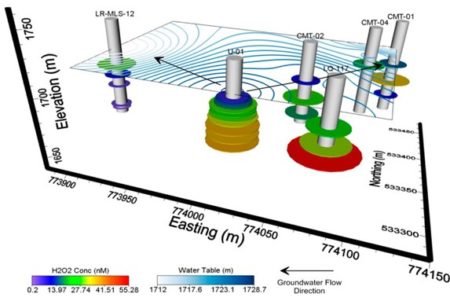Yuan et al. (2017) reports on the first measurement of the presence of hydrogen peroxide concentrations in groundwaters. Hydrogen peroxide and an associated class of compounds called reactive oxygen species have long been known to be important drivers of biogeochemical cycling and contaminant decomposition in surface water (oceans, rivers, and lakes). However, their importance in groundwater was unestablished.
By demonstrating that hydrogen peroxide and therefore the associated group of reactive oxygen species were widely distributed in the groundwaters of our site, the study establishes that they are likely important to the chemistry and function of groundwater systems. The widespread presence of reactive oxygen species may be an explanation for apparent non-equilibrium conditions in some waters as well as organic matter oxidation pathways without other obvious causes. Finally by showing that concentrations tended to be highest at transition zones the work focuses the likely most impactful areas of future investigation.
Summary
The commonly held assumption that photodependent processes dominate H2O2 production in natural waters has been recently questioned. This paper demonstrated for the unrecognized and light-independent generation of H2O2 in groundwater of an alluvial aquifer adjacent to the Colorado River near Rifle, CO. In situ detection using a sensitive chemiluminescent method suggests H2O2 concentrations ranging from lower than the detection limit (<1 nM) to 54 nM along the vertical profiles obtained at various locations across the aquifer. Our results also suggest dark formation of H2O2 is more likely to occur in transitional redox environments where reduced elements (e.g., reduced metals and NOM) meet oxygen, such as oxic–anoxic interfaces. A simplified kinetic model involving interactions among iron, reduced NOM, and oxygen was able to reproduce roughly many, but not all, of the features in our detected H2O2 profiles, and therefore there are other minor biological and/or chemical controls on H2O2 steady-state concentrations in such aquifer. Because of its transient nature, the widespread presence of H2O2 in groundwater suggests the existence of a balance between H2O2 sources and sinks, which potentially involves a cascade of various biogeochemically important processes that could have significant impacts on metal/nutrient cycling in groundwater-dependent ecosystems, such as wetlands and springs. More importantly, our results demonstrate that reactive oxygen species are not only widespread in oceanic and atmospheric systems but also in the subsurface domain, possibly the least understood component of biogeochemical cycles.
Citation
Yuan, X., P. S. Nico, X. Huang, T. Liu, C. Ulrich, K. H. Williams, and J. A. Davis (2017), Production of hydrogen peroxide in groundwater at Rifle, Colorado, Environ. Sci. Technol., DOI: 10.1021/acs.est.6b04803.

